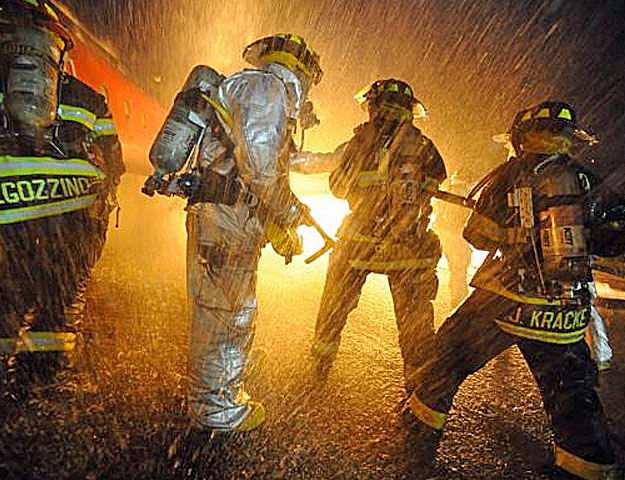
EMERGE: Wearable Technology Accelerator Technology Showcase Open House
Date: Wednesday, March 1, 2017
Time: 9:30 a.m. to 2:00 p.m. EST
Location: Sixth Engine, 438 Massachusetts Avenue NW, Washington, D.C. 20001
First responders have one of the toughest jobs on the planet. They run towards danger and rescue those in need.’
At the DHS Science and Technology Directorate (S&T), we are searching for cutting-edge technology that can help fire fighters, police, and emergency personnel do their jobs even better.
In the fall of 2016, we selected 10 startups to be part of S&T EMERGE Accelerator Program.
EMERGE works with accelerators and incubators to find early-stage companies that have a commercial technology that could be adapted for first responders. This is the second time S&T’s EMERGE Accelerator Program has focused on wearable technology.
Each of the EMERGE startups have a unique technology breaking through the commercial market that we think can be used by first responders.
For the past several months, the EMERGE startups have worked with first responders, test and evaluators, and corporate partners to adapt their technology for first responder use. E
MERGE is part of S&T’s larger focus of tapping into the startup community to find technology for homeland security use.
(Learn More about how S&T is using science and technology advances to address evolving threats. Courtesy of DHS S&T and YouTube)
The Department of Homeland Security (DHS) Science and Technology Directorate (S&T) will host the EMERGE: Wearable Technology Showcase to present the results of the 10 startup companies that were part of this year’s cohort class.
EMERGE works with accelerators and incubators to find early-stage companies that have a commercial technology that could be modified specifically for first responders.
The program includes pilot and path-to-market opportunities with the first responder, corporate, and investor communities.

For the past five months the EMERGE startups have worked with first responders, test and evaluators, and corporate partners to adapt their technology for first responder use.
“Programs like EMERGE help us find and also encourage the development of technology that can help them do their jobs safer, faster, and more efficiently,” said DHS acting Under Secretary for Science and Technology Dr. Robert Griffin.
“The entrepreneurial world is on the leading edge of those inventive solutions, and at S&T we are looking for creative ways to put these technologies in the hands of first responders.”
EMERGE: Wearable Technology Showcase
The Department of Homeland Security (DHS) Science and Technology Directorate will host the EMERGE: Wearable Technology Showcase to review the results of the startups work with first responders and corporate partners on the next generation of first responder wearable technology.
Throughout the day there will be tech talks on innovation, next generation first responder programs, and trends in technology and hazards facing first responders.
Stop by the historic fire house landmark and see what is next as we create the next generation of first responder technology.
Sixth Engine, 438 Massachusetts Avenue NW
Washington, D.C. 20001

The EMERGE technologies to be showcased:
Augmate, New York, New York, developed a provisioning and management platform for wearable devices that helps IT departments track users and their devices, collect sensor data, communicate with workers, and control approved applications and situational connectivity.
CommandWear Systems, Vancouver, British Columbia, Canada, developed a software platform that integrates location and biometrics data from devices to provide personnel tracking, two-way text communication and video sharing to facilitate planning, mission execution, and review operations among teams.
HAAS Alert, Chicago, Illinois / Detroit, Michigan, has a mobile vehicle-to-vehicle communication platform that uses acoustic sensors to pick up environmental and situational noise, and location data to connect people, vehicles, and things in cities, streamlining the disaster and emergency notification process to keep communities safe.
Human Systems Integration, Boston, Massachusetts, developed an integrated system that includes remote physiological monitoring. The system provide a plug and play wearable situational awareness and communications platform.
Lumenus, Los Angeles, California, created smart clothing that uses LED lighting and connectivity to improve visibility of consumers and industrial workers.
LuminAID, Chicago, Illinois, created durable, low cost, and low profile inflatable solar lamps that can be stored efficiently and easily deployed.
Pear Sports, Los Angeles, California, has a coaching and training application that uses biometric signals like heart rate, VO2 max, location, and environmental data to build training programs that improve the long-term health of users.
Six15 Technologies, Henrietta, New York, produced rugged wearable devices for military and industrial use that stream video and display data using augmented reality overlays for better situational awareness.
Vault RMS, San Diego, California, created a software platform that leverages biometric and situational data from wearable devices and other inputs to build a long-term health profile of workers exposed to health-compromising environments, driving improvements in health, safety, and overall worker productivity.
Visual Semantics, Austin, Texas, created software that integrates with cloud-enabled wearable cameras and heads up displays to provide real-time facial recognition and alerts to help first responders more intelligently assess and react to situations in the field.
EMERGE 2016: Wearable Technology is a partnership with the Center for Innovative Technology, a nonprofit corporation in Virginia that is a driver of innovation and entrepreneurship; TechNexus, a venture collaborative that works in conjunction with leading corporations and the global entrepreneurial ecosystem; and the U.S. Department of Energy Pacific Northwest National Laboratory.
(Hear from Dr. Griffin directly from Jan 14, 2015, courtesy of DHS S&T and YouTube)
The details and to register for the March 1 showcase for S&T EMERGE 2016: Wearable Technology program are on the DHS S&T website.
















